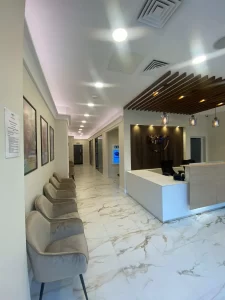The Ideal Dental Clinic Layout and How to Achieve It?
Welcome to our guest post where we delve into the intricacies of dental clinic layouts, aiming to provide invaluable insights for creating the ideal setup. At Divo Interiors LTD, we understand the significance of a well-designed dental office, not only in terms of aesthetics but also functionality, patient comfort, and operational efficiency. In this guide, we’ll explore key components, design principles, practical tips, and real-life examples to help you achieve the perfect dental clinic layout.
Understanding the Key Components
A successful dental clinic layout begins with a thorough understanding of its key components.
- Reception Area Importance: The reception area serves as the initial point of contact for patients, making it crucial in shaping their overall experience. It’s where patients form their first impressions of the clinic’s professionalism and friendliness.
- Setting the Tone: A well-designed reception area can create a welcoming atmosphere, helping patients feel comfortable and at ease from the moment they enter the clinic. Elements such as comfortable seating, soothing decor, and friendly staff contribute to a positive first impression.
- Treatment Room Functionality: Treatment rooms are the heart of any dental clinic, where procedures are performed. They must be equipped with essential dental equipment, an organised layout, and adequate space for both the dentist and assistant to work efficiently.
- Optimal Design: Treatment rooms should be designed with optimal functionality in mind, ensuring easy access to equipment and supplies while maintaining patient comfort and privacy. Proper lighting, ergonomic furniture, and efficient workflow patterns contribute to a smooth operation.
- Sterilisation Area Significance: The sterilisation area is essential for maintaining hygiene and preventing the spread of infections. It requires careful planning to ensure compliance with sterilisation protocols, proper ventilation, and sufficient space for equipment and supplies.
- Staff Spaces Consideration: Staff spaces, including break rooms and administrative areas, are vital for promoting staff well-being and efficiency. Providing comfortable and functional spaces for staff helps foster a positive work environment and enhances overall clinic productivity.
Design Principles for an Ideal Layout
Several design principles contribute to the success of a dental clinic layout. These include considerations such as:
- Patient Flow: Efficient patient flow is essential for a smooth and organised operation within a dental clinic. This involves strategically designing the layout to minimise congestion and bottlenecks, allowing patients to move seamlessly from the reception area to treatment rooms and other areas. Clear signage and well-defined pathways help guide patients through the clinic, enhancing their overall experience and reducing wait times.
- Accessibility: Ensuring accessibility for all patients, including those with disabilities, is paramount in dental clinic layouts. This includes providing wheelchair ramps, wide doorways, and accessible amenities such as restrooms and treatment chairs. By accommodating diverse patient needs, clinics can promote inclusivity and ensure that everyone can access dental services comfortably and safely.
- Infection Control: Infection control is a top priority in healthcare settings, including dental clinics. Designing the layout with infection control protocols in mind involves implementing features such as designated sterilisation areas, proper ventilation systems, and easy-to-clean surfaces. Additionally, ensuring adequate spacing between treatment areas and incorporating barriers or partitions where necessary helps minimise the risk of cross-contamination and maintain a hygienic environment.
- Compliance with Regulations: Dental clinics must adhere to various regulations and standards set forth by regulatory bodies and health authorities. This includes regulations related to building codes, safety standards, and infection control guidelines. Collaborating with experienced designers or architects who are knowledgeable about these regulations is essential to ensure compliance and avoid potential legal issues.
- Patient and Staff Comfort: Creating a comfortable environment for both patients and staff contributes to overall satisfaction and productivity. This involves considerations such as ergonomic furniture, appropriate lighting, temperature control, and noise reduction measures. Investing in quality equipment and furnishings not only enhances comfort but also reflects the professionalism and commitment to excellence of the dental practice. By prioritising comfort, clinics can create a welcoming atmosphere that promotes relaxation and confidence in patients while supporting the well-being of staff members.
Implementing these design principles requires meticulous planning and collaboration with experienced professionals to create a dental clinic layout that not only meets regulatory requirements but also promotes efficiency, safety, and comfort for patients and staff. Additionally, investing in quality equipment and furnishings enhances the clinic’s professional image and creates a welcoming atmosphere for all who enter.

Tips for Achieving the Ideal Dental Clinic Layout
To achieve the ideal dental clinic layout, it’s crucial to conduct a thorough needs assessment and space planning. This involves considering factors such as:
- Needs Assessment: Conducting a thorough needs assessment is the foundational step in achieving the ideal layout for a squat dental practice. This involves analysing the specific requirements of the practice, including its size, location, and target patient demographic. Understanding these factors helps in tailoring the layout to meet the unique needs and preferences of the practice.
- Space Planning: Once the needs assessment is complete, space planning becomes essential. This involves strategically allocating space for different areas of the clinic, such as reception, treatment rooms, sterilisation areas, and staff spaces. Careful consideration is given to factors like patient flow, accessibility, and workflow efficiency to ensure optimal utilisation of space.
- Consideration of Practice Size: The size of the practice directly influences the layout design. A larger practice may require more treatment rooms, a spacious reception area, and additional staff spaces compared to a smaller practice. Adapting the layout to accommodate the scale of the practice ensures that space is utilised effectively without overcrowding or inefficiencies.
- Number of Practitioners: The number of practitioners working in the clinic impacts the layout design, as it determines the need for additional treatment rooms, consultation areas, and staff spaces. Collaborative spaces may be incorporated to facilitate teamwork and communication among practitioners.
- Range of Services Offered: The services offered by the practice also influence the layout design. For example, a practice offering specialised services such as orthodontics or oral surgery may require dedicated treatment rooms equipped with specific equipment and amenities.
- Collaboration with Design Professionals: Collaboration with experienced designers or architects is crucial in optimising space utilisation and workflow efficiency. Design professionals provide valuable insights and expertise in creating a layout that aligns with the practice’s needs and enhances the overall patient and staff experience.
- Regular Evaluation and Updates: Finally, regular evaluation and updates to the layout are essential to ensure it remains aligned with the evolving needs of the practice and its patients. As the practice grows or introduces new services, adjustments to the layout may be necessary to maintain efficiency and effectiveness. Ongoing evaluation helps in identifying areas for improvement and implementing necessary changes to optimise the clinic’s operations.
Conclusion
Crafting the perfect dental clinic layout is a multifaceted endeavor that requires careful consideration of various factors, from patient flow to compliance with regulations. At Divo Interiors LTD, we’re dedicated to helping dental practitioners achieve their vision for an ideal practice environment. By prioritising functionality, comfort, and aesthetics, our team collaborates with clients to create bespoke solutions tailored to their unique needs. Whether you’re embarking on a new clinic design or revamping an existing practice, we’re here to guide you every step of the way.

